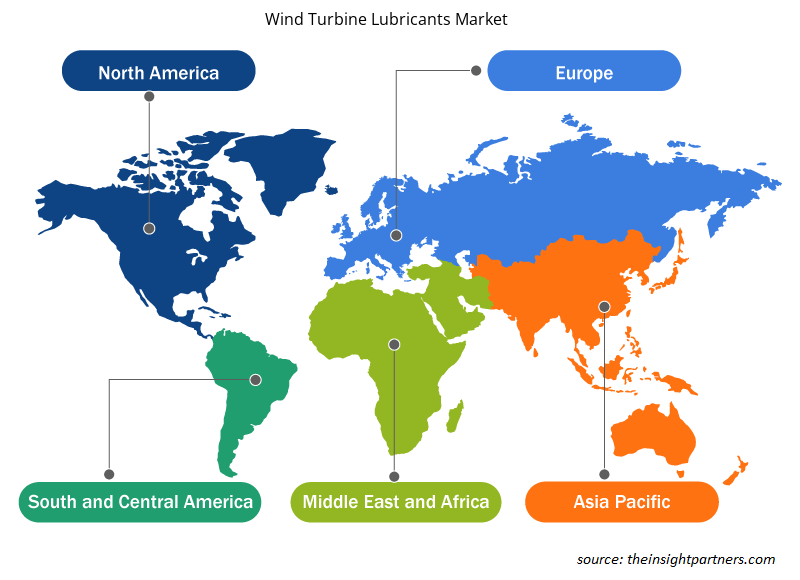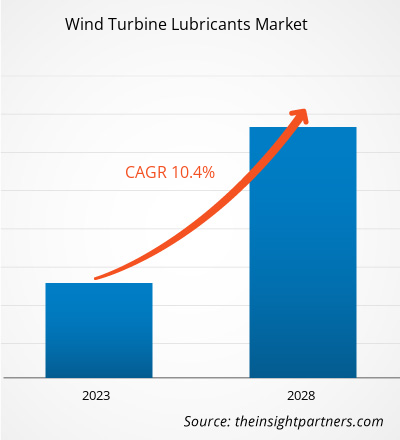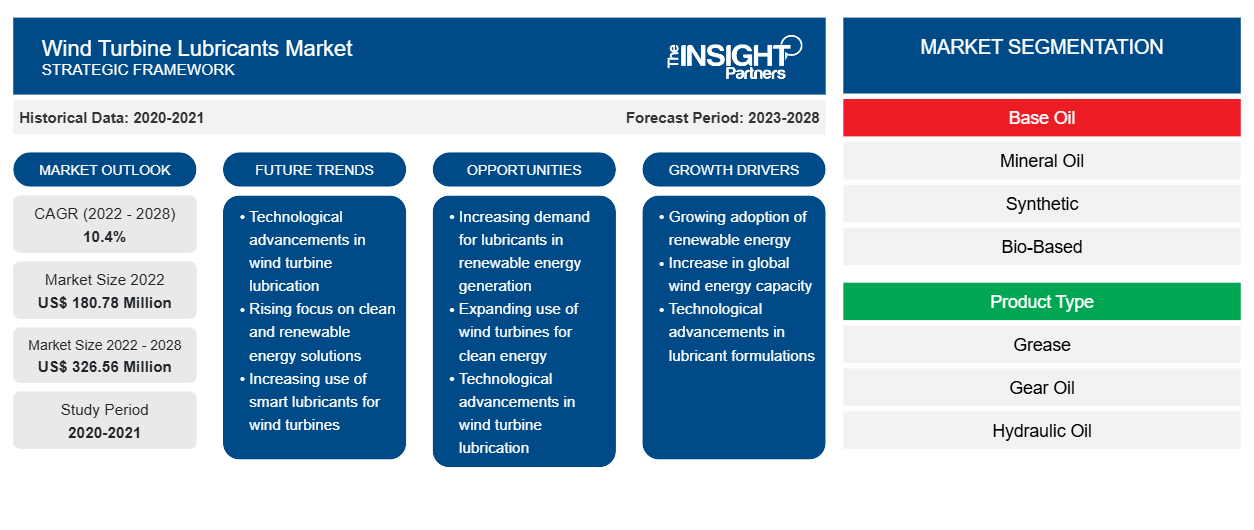[Informe de investigación] Se espera que el tamaño del mercado de lubricantes para turbinas eólicas crezca de US$ 180,78 millones en 2022 a US$ 326,56 millones en 2028; se estima que registrará una CAGR del 10,4% de 2022 a 2028.
Los lubricantes para turbinas eólicas desempeñan un papel importante en la operación, el mantenimiento y la confiabilidad de los equipos en los parques eólicos. Las turbinas eólicas tienen varios puntos de lubricación, como la caja de cambios, el engranaje abierto, el engranaje de paso, el cojinete de paso, el cojinete de guiñada, los sistemas hidráulicos y los cojinetes del generador. Los diferentes lubricantes utilizados en las turbinas eólicas son los aceites para engranajes, los aceites hidráulicos y las grasas. El aceite para engranajes se utiliza para lubricar las cajas de cambios. En las turbinas eólicas, la grasa se utiliza en el cojinete del eje del rotor principal, el cojinete de guiñada, los engranajes de transmisión de paso, el cojinete de las palas y el cojinete del generador.
La cuota de mercado mundial de lubricantes para turbinas eólicas en Asia Pacífico fue la más grande en 2022. El mercado de lubricantes para turbinas eólicas en Asia Pacífico está segmentado en Australia, China, India, Japón, Corea del Sur y el resto de Asia Pacífico. China es un importante contribuyente al crecimiento del mercado en esta región. El país ha sido el mayor productor de energía renovable del mundo y de más rápido crecimiento durante más de una década. Además, tiene el mercado de energía eólica más grande del mundo. China siguió siendo el mayor mercado del mundo para nuevas incorporaciones terrestres en 2020, impulsado por el corte de la tarifa de alimentación (FiT). India también registró un crecimiento notable de la industria de la energía eólica debido a varias políticas y regulaciones favorables adoptadas por los gobiernos nacionales y estatales. Además, países como Taiwán, Corea del Sur, Vietnam y Filipinas también están tomando varias iniciativas para aumentar sus capacidades eólicas instaladas, lo que aumenta la demanda de lubricantes para turbinas eólicas de la región.
Personalice este informe según sus necesidades
Obtendrá personalización en cualquier informe, sin cargo, incluidas partes de este informe o análisis a nivel de país, paquete de datos de Excel, así como también grandes ofertas y descuentos para empresas emergentes y universidades.
- Obtenga las principales tendencias clave del mercado de este informe.Esta muestra GRATUITA incluirá análisis de datos, desde tendencias del mercado hasta estimaciones y pronósticos.
Impacto de la pandemia de COVID-19 en el mercado de lubricantes para turbinas eólicas
El apoyo gubernamental a las energías renovables y el aumento de las instalaciones de turbinas eólicas han contribuido en gran medida al crecimiento del mercado de lubricantes para turbinas eólicas. Sin embargo, en 2020, varias industrias tuvieron que ralentizar sus operaciones debido a las interrupciones en la cadena de valor causadas por las restricciones en las fronteras nacionales e internacionales. Esto provocó el cierre de las instalaciones de producción, lo que afectó negativamente al crecimiento del mercado de lubricantes para turbinas eólicas a principios de 2020. La disminución de las instalaciones eólicas a principios de 2020 impidió la demanda de lubricantes para turbinas eólicas.
Sin embargo, el sector de la energía eólica se recuperó con vigor en la segunda mitad del año a medida que los mercados eólicos maduros y emergentes comenzaron a superar los impactos de la pandemia. Además, el mercado global comenzó a recuperarse de las pérdidas sufridas anteriormente durante la pandemia a medida que los gobiernos de diferentes países anunciaron relajaciones en las restricciones sociales. Además, las crecientes tasas de vacunación generaron entornos propicios para el progreso industrial. Según el Consejo Mundial de Energía Eólica, la industria eólica mundial fue testigo de un crecimiento interanual récord (YoY) del 53% en 2020. La industria instaló más de 93 GW de energía eólica durante el pico de la pandemia de COVID-19 a pesar de las interrupciones en la cadena de suministro global y la construcción de proyectos . Un aumento en la capacidad eólica instalada resultó en una mayor demanda de lubricantes para turbinas eólicas, ya que los lubricantes se utilizan para lubricar diferentes partes de las turbinas eólicas.
Perspectivas del mercado
El aumento de la capacidad eólica instalada impulsa la demanda de lubricantes para turbinas eólicas
La energía eólica ayuda a reducir la dependencia de los combustibles fósiles, lo que se traduce en un creciente interés por este recurso renovable en diferentes países. Según el “Informe Global Wind 2021” publicado por el Global Wind Energy Council, en 2020, las nuevas instalaciones de energía eólica superaron los 90 GW, es decir, un 53% más que la capacidad añadida en 2019. Esto se tradujo en una capacidad instalada total de 743 GW en el mundo, registrando un aumento del 14% respecto a 2019. En 2020, las nuevas instalaciones en los parques eólicos terrestres alcanzaron los 86,9 GW, mientras que los parques eólicos marinos alcanzaron los 6,1 GW, lo que convierte a 2020 en el año más alto y el segundo más alto de la historia en nuevas instalaciones eólicas terrestres y marinas, respectivamente. Varias partes de la turbina eólica necesitan lubricarse con grasas, aceites para engranajes, aceites hidráulicos y otros lubricantes. Por tanto, la creciente capacidad eólica instalada a nivel mundial está impulsando el crecimiento del mercado de lubricantes para turbinas eólicas.
Perspectivas sobre el petróleo base
Según el aceite base, el mercado mundial de lubricantes para turbinas eólicas se segmenta en aceite mineral, sintético y de base biológica. El segmento sintético tuvo la mayor participación de mercado de lubricantes para turbinas eólicas en 2022. Los lubricantes sintéticos están hechos de componentes de aceite que se han fabricado sintéticamente a través de la reacción de unos pocos compuestos químicos bien definidos, que a menudo son de base petrolífera en lugar de refinados a partir de crudos de petróleo existentes o aceites vegetales. Los lubricantes sintéticos son los lubricantes más utilizados en la industria de las turbinas eólicas, ya que los aceites sintéticos tienen un punto de fluidez más bajo, lo que permite que la caja de cambios funcione de manera eficiente a temperaturas más bajas.
Los actores clave que operan en el mercado global de lubricantes para turbinas eólicas incluyen TotalEnergies, Exxon Mobil Corporation, FUCHS, BP plc, Klüber Lubrication, Shell, Phillips 66 Company, Chevron, Afton Chemical, AMSOIL INC. y The Lubrizol Corporation. Los actores del mercado global se centran en proporcionar productos de alta calidad para satisfacer la demanda de los clientes. Para ello, invierten significativamente en actividades de investigación y desarrollo.
Informe Destacado
- Tendencias progresivas de la industria en el mercado de lubricantes para turbinas eólicas para ayudar a los actores a desarrollar estrategias efectivas a largo plazo
- Estrategias de crecimiento empresarial adoptadas por los mercados desarrollados y en desarrollo
- Análisis cuantitativo del mercado de lubricantes para aerogeneradores de 2020 a 2028
- Estimación de la demanda mundial de lubricantes para turbinas eólicas
- Análisis de las cinco fuerzas de Porter para ilustrar la eficacia de los compradores y proveedores que operan en la industria
- Avances recientes para comprender el escenario competitivo del mercado
- Tendencias y perspectivas del mercado, así como factores que impulsan y restringen el crecimiento del mercado de lubricantes para turbinas eólicas
- Asistencia en el proceso de toma de decisiones destacando las estrategias de mercado que sustentan el interés comercial, lo que conduce al crecimiento del mercado.
- El tamaño del mercado de lubricantes para turbinas eólicas en varios nodos
- Descripción detallada y segmentación del mercado, así como la dinámica de la industria de lubricantes para turbinas eólicas
- El tamaño del mercado de lubricantes para turbinas eólicas en varias regiones con oportunidades de crecimiento prometedoras
Perspectivas regionales del mercado de lubricantes para turbinas eólicas
Los analistas de Insight Partners han explicado detalladamente las tendencias y los factores regionales que influyen en el mercado de lubricantes para turbinas eólicas durante el período de pronóstico. Esta sección también analiza los segmentos y la geografía del mercado de lubricantes para turbinas eólicas en América del Norte, Europa, Asia Pacífico, Oriente Medio y África, y América del Sur y Central.

- Obtenga datos regionales específicos para el mercado de lubricantes para turbinas eólicas
Alcance del informe de mercado de lubricantes para turbinas eólicas
| Atributo del informe | Detalles |
|---|---|
| Tamaño del mercado en 2022 | US$ 180,78 millones |
| Tamaño del mercado en 2028 | US$ 326,56 millones |
| CAGR global (2022-2028) | 10,4% |
| Datos históricos | 2020-2021 |
| Período de pronóstico | 2023-2028 |
| Segmentos cubiertos | Por aceite base
|
| Regiones y países cubiertos | América del norte
|
| Líderes del mercado y perfiles de empresas clave |
|
Densidad de actores del mercado de lubricantes para turbinas eólicas: comprensión de su impacto en la dinámica empresarial
El mercado de lubricantes para turbinas eólicas está creciendo rápidamente, impulsado por la creciente demanda de los usuarios finales debido a factores como la evolución de las preferencias de los consumidores, los avances tecnológicos y una mayor conciencia de los beneficios del producto. A medida que aumenta la demanda, las empresas amplían sus ofertas, innovan para satisfacer las necesidades de los consumidores y aprovechan las tendencias emergentes, lo que impulsa aún más el crecimiento del mercado.
La densidad de actores del mercado se refiere a la distribución de las empresas o firmas que operan dentro de un mercado o industria en particular. Indica cuántos competidores (actores del mercado) están presentes en un espacio de mercado determinado en relación con su tamaño o valor total de mercado.
Las principales empresas que operan en el mercado de lubricantes para turbinas eólicas son:
- TotalEnergies SE
- Compañía BP plc
- Cheurón
- Corporación Exxon Mobil
- Lubricantes FUCHS SE
Descargo de responsabilidad : Las empresas enumeradas anteriormente no están clasificadas en ningún orden particular.

- Obtenga una descripción general de los principales actores clave del mercado de lubricantes para turbinas eólicas
Mercado de lubricantes para aerogeneradores
Según el aceite base, el mercado de lubricantes para turbinas eólicas se segmenta en aceite mineral, sintético y de base biológica. El mercado global de lubricantes para turbinas eólicas se segmenta según el tipo de producto en grasa, aceite para engranajes, aceite hidráulico y otros.
Perfiles de empresas
- TotalEnergies SE
- Compañía BP plc
- Cheurón
- Corporación Exxon Mobil
- Lubricantes FUCHS SE
- Empresa de lubricación Klüber Lubrication GmbH & Co.
- Compañía Phillips 66
- Shell Sociedad Anónima
- La Corporación Lubrizol
- Química Afton
- Compañía: AMSOIL INC.
- Análisis histórico (2 años), año base, pronóstico (7 años) con CAGR
- Análisis PEST y FODA
- Tamaño del mercado, valor/volumen: global, regional y nacional
- Industria y panorama competitivo
- Conjunto de datos de Excel
Informes recientes
Informes relacionados
Testimonios
Razón para comprar
- Toma de decisiones informada
- Comprensión de la dinámica del mercado
- Análisis competitivo
- Información sobre clientes
- Pronósticos del mercado
- Mitigación de riesgos
- Planificación estratégica
- Justificación de la inversión
- Identificación de mercados emergentes
- Mejora de las estrategias de marketing
- Impulso de la eficiencia operativa
- Alineación con las tendencias regulatorias





















 Obtenga una muestra gratuita para - Mercado de lubricantes para aerogeneradores
Obtenga una muestra gratuita para - Mercado de lubricantes para aerogeneradores